Rotterdam
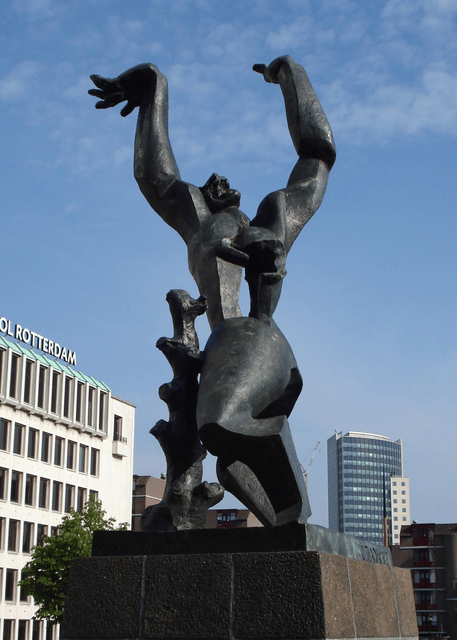
Rotterdam

Rotterdam | |
|---|---|
Municipality | |
From top down, left to right: Rotterdam at dusk, Lawrence Church, The Destroyed City sculpture, Euromast, Cube houses, De Kuip; stadium of Feyenoord, City Hall of Rotterdam, Schieland House, Hotel New York, Historic town centre of Delfshaven, Port of Rotterdam | |
| Nickname(s): Rotown, Roffa, Rotjeknor, Nultien | |
| Motto(s): Sterker door strijd (Stronger through struggle) | |
 Location in South Holland | |
| Coordinates:51°55′N 4°30′E [82] | |
| Country | |
| Province | |
| Districts | Fourteen
|
| Government | |
| • Body | Municipal council |
| • Mayor | Ahmed Aboutaleb (PvdA) |
| • Aldermen | List
|
| Area | |
| • Municipality | 325.79 km2(125.79 sq mi) |
| • Land | 208.80 km2(80.62 sq mi) |
| • Water | 116.99 km2(45.17 sq mi) |
| • Randstad | 3,043 km2(1,175 sq mi) |
| Elevation | 0 m (0 ft) |
| Population | |
| • Municipality | 635,389 |
| • Density | 3,043/km2(7,880/sq mi) |
| • Urban | 1,015,215 |
| • Metro | 1,181,284 |
| • Metropolitan region | 2,261,844 |
| • Randstad | 8,219,380 |
| Demonym(s) | Rotterdammer |
| Time zone | UTC+1 (CET) |
| • Summer (DST) | UTC+2 (CEST) |
| Postcode | 3000–3099 |
| Area code | 010 |
| Website | www.rotterdam.nl [83] |
| City of Rotterdam population by country of origin (2018)[27] | |
| Country/Territory | Population |
| 313,861 (49.1%) | |
| 52,620 (8.2%) | |
| 47,712 (7.5%) | |
| 44,164 (6.9%) | |
| 24,836 (3.9%) | |
| 15,411 (2.4%) | |
| 11,952 (1.9%) | |
| 9,714 (1.5%) | |
| 9,565 (1.5%) | |
| 9,369 (1.5%) | |
| 7,218 (1.1%) | |
| Other | 92,290 (14.5%) |
Rotterdam (/ˈrɒtərdæm/, UK also /ˌrɒtərˈdæm/;[8][9] Dutch: [ˌrɔtərˈdɑm] (listen)) is the second-largest city after Amsterdam and municipality of the Netherlands. It is located in the province of South Holland, at the mouth of the Nieuwe Maas channel leading into the Rhine–Meuse–Scheldt delta at the North Sea. Its history goes back to 1270, when a dam was constructed in the Rotte, after which people settled around it for safety. In 1340, Rotterdam was granted city rights by the Count of Holland.[10]
A major logistic and economic centre, Rotterdam is Europe's largest port, and had previously been the largest port of the world for a long time. It has a population of 634,660 and is home to 174 nationalities.[11] Rotterdam is known for its Erasmus University, its riverside setting, lively cultural life, maritime heritage and modern architecture. The near-complete destruction of the city centre in the World War II Rotterdam Blitz has resulted in a varied architectural landscape, including sky-scrapers (an uncommon sight in other Dutch cities) designed by renowned architects such as Rem Koolhaas, Piet Blom and Ben van Berkel.[12][13]
The Rhine, Meuse and Scheldt give waterway access into the heart of Western Europe, including the highly industrialized Ruhr. The extensive distribution system including rail, roads, and waterways have earned Rotterdam the nicknames "Gateway to Europe" and "Gateway to the World".[14][15][16] Rotterdam will host the Eurovision Song Contest 2020.
Rotterdam | |
|---|---|
Municipality | |
From top down, left to right: Rotterdam at dusk, Lawrence Church, The Destroyed City sculpture, Euromast, Cube houses, De Kuip; stadium of Feyenoord, City Hall of Rotterdam, Schieland House, Hotel New York, Historic town centre of Delfshaven, Port of Rotterdam | |
| Nickname(s): Rotown, Roffa, Rotjeknor, Nultien | |
| Motto(s): Sterker door strijd (Stronger through struggle) | |
 Location in South Holland | |
| Coordinates:51°55′N 4°30′E [82] | |
| Country | |
| Province | |
| Districts | Fourteen
|
| Government | |
| • Body | Municipal council |
| • Mayor | Ahmed Aboutaleb (PvdA) |
| • Aldermen | List
|
| Area | |
| • Municipality | 325.79 km2(125.79 sq mi) |
| • Land | 208.80 km2(80.62 sq mi) |
| • Water | 116.99 km2(45.17 sq mi) |
| • Randstad | 3,043 km2(1,175 sq mi) |
| Elevation | 0 m (0 ft) |
| Population | |
| • Municipality | 635,389 |
| • Density | 3,043/km2(7,880/sq mi) |
| • Urban | 1,015,215 |
| • Metro | 1,181,284 |
| • Metropolitan region | 2,261,844 |
| • Randstad | 8,219,380 |
| Demonym(s) | Rotterdammer |
| Time zone | UTC+1 (CET) |
| • Summer (DST) | UTC+2 (CEST) |
| Postcode | 3000–3099 |
| Area code | 010 |
| Website | www.rotterdam.nl [83] |
| City of Rotterdam population by country of origin (2018)[27] | |
| Country/Territory | Population |
| 313,861 (49.1%) | |
| 52,620 (8.2%) | |
| 47,712 (7.5%) | |
| 44,164 (6.9%) | |
| 24,836 (3.9%) | |
| 15,411 (2.4%) | |
| 11,952 (1.9%) | |
| 9,714 (1.5%) | |
| 9,565 (1.5%) | |
| 9,369 (1.5%) | |
| 7,218 (1.1%) | |
| Other | 92,290 (14.5%) |
History
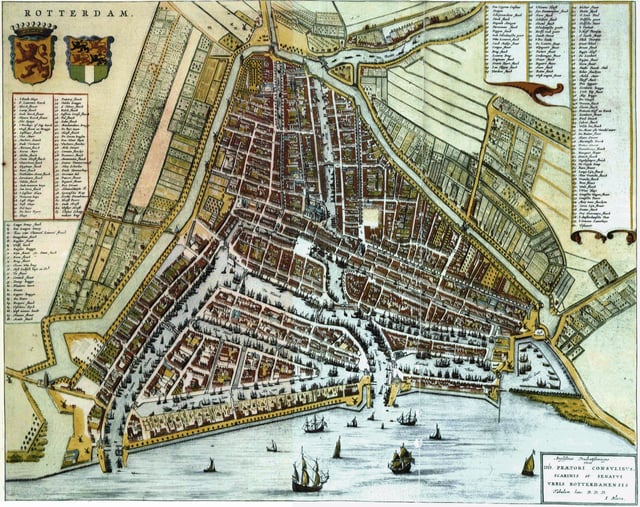
Map of Rotterdam by Willem and Joan Blaeu (1652)

The Delftsevaart, c. 1890–1905

Rotterdam centre after the 1940 bombing of Rotterdam. The ruined St. Lawrence' Church has been restored
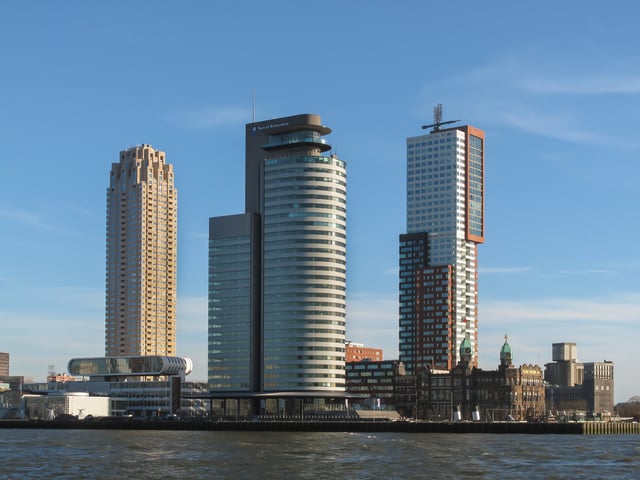
Tower blocks in the Kop van Zuid neighbourhood
The settlement at the lower end of the fen stream Rotte (or Rotta, as it was then known, from rot, "muddy" and a, "water", thus "muddy water") dates from at least 900 CE. Around 1150, large floods in the area ended development, leading to the construction of protective dikes and dams, including Schielands Hoge Zeedijk ("Schieland’s High Sea Dike") along the northern banks of the present-day Nieuwe Maas. A dam on the Rotte was built in the 1260s and was located at the present-day Hoogstraat ("High Street").
On 7 July 1340, Count Willem IV of Holland granted city rights to Rotterdam, whose population then was only a few thousand.[10] Around the year 1350, a shipping canal, the Rotterdamse Schie was completed, which provided Rotterdam access to the larger towns in the north, allowing it to become a local trans-shipment centre between the Netherlands, England and Germany, and to urbanize.[17]
The port of Rotterdam grew slowly but steadily into a port of importance, becoming the seat of one of the six "chambers" of the Vereenigde Oostindische Compagnie (VOC), the Dutch East India Company.
The greatest spurt of growth, both in port activity and population, followed the completion of the Nieuwe Waterweg in 1872. The city and harbor started to expand on the south bank of the river. The Witte Huis or White House skyscraper,[18] inspired by American office buildings and built in 1898 in the French Château-style, is evidence of Rotterdam's rapid growth and success. When completed, it was the tallest office building in Europe, with a height of 45 m (147.64 ft).
During World War I, the city was the world's largest spy centre because of Dutch neutrality and its strategic location in between Britain, Germany and German-occupied Belgium. Many spies who were arrested and executed in Britain were led by German secret agents operating from Rotterdam. MI6 had its main European office on de Boompjes. From there the British coordinated espionage in Germany and occupied Belgium. During World War I, an average of 25,000 Belgian refugees lived in the city, as well as hundreds of German deserters and escaped Allied prisoners of war.[19]
During World War II, the German army invaded the Netherlands on 10 May 1940.[20] Adolf Hitler had hoped to conquer the country in just one day, but his forces met unexpectedly fierce resistance. The Dutch army was forced to capitulate on 15 May 1940, following the bombing of Rotterdam on 14 May and the threat of bombing of other Dutch cities.[21][22][23] The heart of Rotterdam was almost completely destroyed by the Luftwaffe. Some 80,000 civilians were made homeless and 900 were killed; a relatively low number due to the fact that many had fled the city because of the warfare and bombing going on in Rotterdam since the start of the invasion three days earlier. The City Hall survived the bombing. Ossip Zadkine later attempted to capture the event with his statue De Verwoeste Stad ('The Destroyed City'). The statue stands near the Leuvehaven, not far from the Erasmusbrug in the centre of the city, on the north shore of the river Nieuwe Maas.
Rotterdam was gradually rebuilt from the 1950s through to the 1970s. It remained quite windy and open until the city councils from the 1980s on began developing an active architectural policy. Daring and new styles of apartments, office buildings and recreation facilities resulted in a more 'livable' city centre with a new skyline. In the 1990s, the Kop van Zuid was built on the south bank of the river as a new business centre. Rotterdam was voted 2015 European City of the Year by the Academy of Urbanism.[13] A Guardian profile of Rem Koolhaas begins "If you put the last 50 years of architecture in a blender, and spat it out in building-sized chunks across the skyline, you would probably end up with something that looked a bit like Rotterdam."[24]
Geography
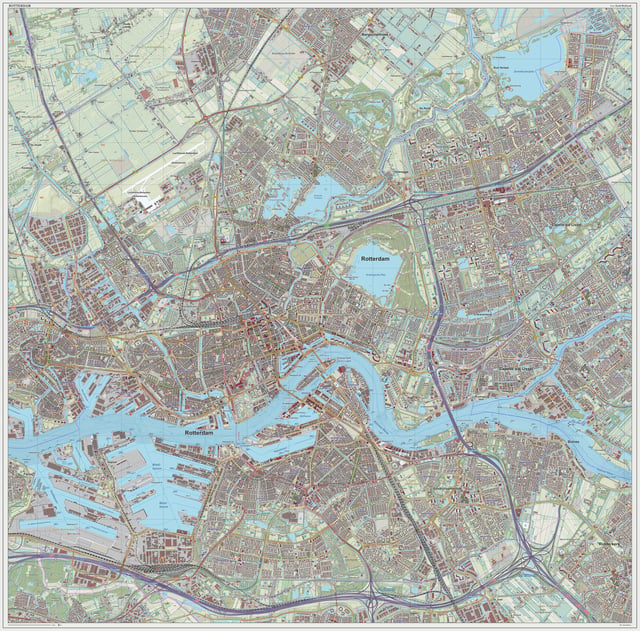
Topographic map image of Rotterdam (city), as of Sept. 2014
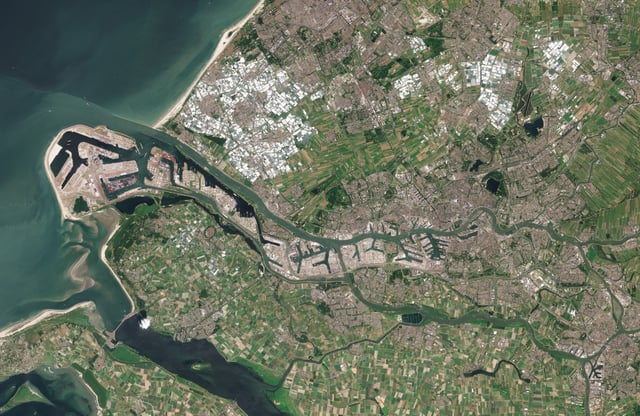
Satellite image of Rotterdam and its port

The 24 municipalities of the Rotterdam The Hague Metropolitan Area
'Rotterdam' is divided into a northern and a southern part by the river Nieuwe Maas, connected by (from west to east): the Beneluxtunnel; the Maastunnel; the Erasmusbrug ('Erasmus Bridge'); a subway tunnel; the Willemsspoortunnel ('Willems railway tunnel'); the Willemsbrug ('Willems Bridge'); the Koninginnebrug ('Queen's Bridge'); and the Van Brienenoordbrug ('Van Brienenoord Bridge'). The former railway lift bridge De Hef ('the Lift') is preserved as a monument in lifted position between the Noordereiland ('North Island') and the south of Rotterdam.
The city centre is located on the northern bank of the Nieuwe Maas, although recent urban development has extended the centre to parts of southern Rotterdam known as De Kop van Zuid ('the Head of South', i.e. the northern part of southern Rotterdam). From its inland core, Rotterdam reaches the North Sea by a swathe of predominantly harbour area.
Built mostly behind dikes, large parts of the Rotterdam are below sea level. For instance, the Prins Alexander Polder in the northeast of Rotterdam extends 6 metres (20 ft) below sea level, or rather below Normaal Amsterdams Peil (NAP) or 'Amsterdam Ordnance Datum'. The lowest point in the Netherlands (6.76 metres (22.2 ft) below NAP) is situated just to the east of Rotterdam, in the municipality of Nieuwerkerk aan den IJssel.
The Rotte river no longer joins the Nieuwe Maas directly. Since the early 1980s, when the construction of Rotterdam’s second subway line interfered with the Rotte’s course, its waters have been pumped through a pipe into the Nieuwe Maas via the Boerengat.
Between the summers of 2003 and 2008, an artificial beach was created at the Boompjeskade along the Nieuwe Maas, between the Erasmus Bridge and the Willems Bridge. Swimming was not possible, digging pits was limited to the height of the layer of sand, about 50 cm (20 in). Alternatively people go the beach of Hoek van Holland (which is a Rotterdam district) or one of the beaches in Zeeland: Renesse or the Zuid Hollandse Eilanden: Ouddorp, Oostvoorne.
Rotterdam forms the centre of the Rijnmond conurbation, bordering the conurbation surrounding The Hague to the north-west. The two conurbations are close enough to be a single conurbation. They share the Rotterdam The Hague Airport and a light rail system called RandstadRail. Consideration is being given to creating an official Metropolitan region Rotterdam The Hague (Metropoolregio Rotterdam Den Haag), which would have a combined population approaching 2.5 million.
On its turn, the Rijnmond conurbation is part of the southern wing (the Zuidvleugel) of the Randstad, which is one of the most important economic and densely populated areas in the north-west of Europe. Having a population of 7.1 million, the Randstad is the sixth-largest urban area in Europe (after Moscow, London, Paris, Istanbul, and the Rhein-Ruhr Area). The Zuidvleugel, situated in the province of South Holland, has a population of around 3 million.
Climate
Rotterdam experiences a temperate oceanic climate (Köppen climate classification Cfb) similar to all of the coastal areas in Netherlands. Located near to the coast, its climate is slightly milder than locations further inland. Winters are cool with frequent cold days, while the summers are mild to warm, with occasional hot temperatures. Temperatures above 30 °C are not rare during summer, while tempatures rarely drop below -5 °C during winter. The following climate box is from the airport, which is slightly cooler than the city, being surrounded by water canals which make the climate milder and with a higher Relative Humidity. The city experiences the Urban heat island effect, especially inside the city centre.
| Climate data for Rotterdam The Hague Airport (1981-2010) | |||||||||||||
|---|---|---|---|---|---|---|---|---|---|---|---|---|---|
| Month | Jan | Feb | Mar | Apr | May | Jun | Jul | Aug | Sep | Oct | Nov | Dec | Year |
| Record high °C (°F) | 14.1 (57.4) | 16.7 (62.1) | 23.8 (74.8) | 27.5 (81.5) | 31.3 (88.3) | 33.0 (91.4) | 37.2 (99.0) | 34.9 (94.8) | 32.1 (89.8) | 26.0 (78.8) | 18.5 (65.3) | 15.1 (59.2) | 37.2 (99.0) |
| Average high °C (°F) | 6.0 (42.8) | 6.6 (43.9) | 9.9 (49.8) | 13.5 (56.3) | 17.5 (63.5) | 19.9 (67.8) | 22.2 (72.0) | 22.1 (71.8) | 18.9 (66.0) | 14.7 (58.5) | 9.9 (49.8) | 6.6 (43.9) | 14.0 (57.2) |
| Daily mean °C (°F) | 3.6 (38.5) | 3.7 (38.7) | 6.4 (43.5) | 9.1 (48.4) | 12.9 (55.2) | 15.5 (59.9) | 17.8 (64.0) | 17.6 (63.7) | 14.8 (58.6) | 11.2 (52.2) | 7.3 (45.1) | 4.2 (39.6) | 10.4 (50.7) |
| Average low °C (°F) | 0.8 (33.4) | 0.5 (32.9) | 2.6 (36.7) | 4.3 (39.7) | 7.8 (46.0) | 10.6 (51.1) | 13.1 (55.6) | 12.8 (55.0) | 10.6 (51.1) | 7.5 (45.5) | 4.2 (39.6) | 1.4 (34.5) | 6.4 (43.5) |
| Record low °C (°F) | −17.1 (1.2) | −16.5 (2.3) | −13.4 (7.9) | −6.0 (21.2) | −1.4 (29.5) | 0.5 (32.9) | 3.6 (38.5) | 4.6 (40.3) | 0.4 (32.7) | −5.1 (22.8) | −9.0 (15.8) | −13.3 (8.1) | −17.1 (1.2) |
| Average precipitation mm (inches) | 69.1 (2.72) | 57.9 (2.28) | 64.9 (2.56) | 42.6 (1.68) | 58.3 (2.30) | 65.2 (2.57) | 74.0 (2.91) | 81.0 (3.19) | 87.1 (3.43) | 90.1 (3.55) | 87.1 (3.43) | 78.3 (3.08) | 855.6 (33.69) |
| Average precipitation days(≥ 1 mm) | 12 | 10 | 12 | 9 | 9 | 10 | 10 | 10 | 12 | 12 | 13 | 13 | 131 |
| Average snowy days | 6 | 5 | 4 | 2 | 0 | 0 | 0 | 0 | 0 | 0 | 2 | 4 | 22 |
| Average relative humidity (%) | 88 | 85 | 83 | 78 | 77 | 79 | 79 | 80 | 84 | 86 | 89 | 89 | 83 |
| Mean monthly sunshine hours | 62.5 | 83.8 | 124.0 | 174.9 | 213.9 | 203.6 | 213.1 | 196.6 | 137.6 | 106.9 | 60.4 | 46.7 | 1,623.8 |
| Source #1: Royal Netherlands Meteorological Institute (1981–2010 normals, snowy days normals for 1971–2000)[25] | |||||||||||||
| Source #2: Royal Netherlands Meteorological Institute (1971–2000 extremes)[26] | |||||||||||||
Demographics
| Historical population | ||||||||||||||||||||||||||||||||||||||||||||||||||||||||||||||||||||||||||||
|---|---|---|---|---|---|---|---|---|---|---|---|---|---|---|---|---|---|---|---|---|---|---|---|---|---|---|---|---|---|---|---|---|---|---|---|---|---|---|---|---|---|---|---|---|---|---|---|---|---|---|---|---|---|---|---|---|---|---|---|---|---|---|---|---|---|---|---|---|---|---|---|---|---|---|---|---|
|
| |||||||||||||||||||||||||||||||||||||||||||||||||||||||||||||||||||||||||||
| Source: Lourens & Lucassen 1997, pp. 116–117 (1398–1795) | ||||||||||||||||||||||||||||||||||||||||||||||||||||||||||||||||||||||||||||
Overall the demographics differ per city area. According to a recent area analysis, the city centre has a singles population of 70%, between the ages of 20 and 40,[28] considerably more than other city areas. Also the city centre has a much larger population of people with higher education and higher income. Nonetheless, 80% of the homes are rented, not owned. The city centre also has a higher percentage (51% vs 45%) of foreign-born citizens. The majority (70%) of shops are also run by foreign-born citizens.[29]
Composition
The municipality of Rotterdam is part of the Rotterdam-The Hague Metropolitan Area which, as of 2015, covers an area of 1,130 km2, of which 990 km km2 is land, and has a population of approximately 2,563,197. As of 2019, the municipality itself occupies an area of 325.79 km2, 208.80 km2 of which is land, and is home to 638,751 inhabitants.[30] Its population peaked at 731,564 in 1965, but the dual processes of suburbanization and counterurbanization saw this number steadily decline over the next 2 decades, reaching 560,000 by 1985.[31][32] Although Rotterdam has experienced population growth since then, it has done so at a slower pace than comparable cities in the Netherlands, like Amsterdam, The Hague and Utrecht .[32]
Rotterdam consists of 14 submunicipalities: Centrum, Charlois (including Heijplaat), Delfshaven, Feijenoord, Hillegersberg-Schiebroek, Hoek van Holland, Hoogvliet, IJsselmonde, Kralingen-Crooswijk, Noord, Overschie, Pernis, and Prins Alexander (the most populous submunicipality with around 85,000 inhabitants). One other area, Rozenburg, does have an official submunicipality status since 18 March 2010.
The current size of the municipality of Rotterdam is the result of the amalgamation of the following former municipalities,[33] some of which now are a submunicipality:
Delfshaven (added on 30 January 1886)
Charlois (added on 28 February 1895)
Kralingen (added on 28 February 1895)
Hoogvliet (added on 1 May 1934)
Pernis (added on 1 May 1934)
Hillegersberg (added on 1 August 1941)
IJsselmonde (added on 1 August 1941)
Overschie (added on 1 August 1941)
Schiebroek (added on 1 August 1941)
Rozenburg (added on 18 March 2010)
Ethnic make-up
In the Netherlands, Rotterdam has the highest percentage of foreigners from non-industrialised nations. They form a large part of Rotterdam's multi ethnic and multicultural diversity. 50.3% of the population are of non Dutch origins or have at least one parent born outside the country. There are 80,000 Muslims, constituting 13% of the population.[34] The mayor of Rotterdam, Ahmed Aboutaleb, is of Moroccan descent and is a practicing Muslim. The city is home to the largest Dutch Antillean community. The city also has its own China Town at the West-Kruiskade, close to Rotterdam Centraal.
Religion
Christianity is the largest religion in Rotterdam, with 31.1% of the population identifying. The second and third largest religions are Islam (13.3%) and Hinduism (3.3%), while about half of the population has no religious affiliation.
Since 1795 Rotterdam has hosted the chief congregation of the liberal Protestant brotherhood of Remonstrants. From 1955 it has been the see of the bishop of Rotterdam when the Rotterdam diocese was split from the Haarlem diocese. Since 2010 the city is home to the largest mosque in the Netherlands, the Essalam mosque, (capacity 1,500).
Economy

Gebouw Delftse Poort, one of the tallest office buildings in the Netherlands
Rotterdam has always been one of the main centres of the shipping industry in the Netherlands. From the Rotterdam Chamber of the VOC, the world's first multinational, established in 1602, to the merchant shipping leader Royal Nedlloyd established in 1970, with its corporate headquarters located in the landmark building the 'Willemswerf' in 1988.[36] In 1997, Nedlloyd merged with the British shipping industry leader P&O forming the third largest merchant shipping company in the world. The Anglo-Dutch P&O Nedlloyd was bought by the Danish giant corporation 'AP Moller Maersk' in 2005 and its Dutch operations are still headquartered in the 'Willemswerf'.
Nowadays, well-known companies with headquarters in Rotterdam are consumers goods company Unilever, asset management firm Robeco, energy company Eneco, dredging company Van Oord, oil company Shell Downstream, terminal operator Vopak, commodity trading company Vitol and architecture firm Office for Metropolitan Architecture. It is also home to the regional headquarters of chemical company LyondellBasell, commodities trading company Glencore, pharmaceutical company Pfizer, logistics companies Stolt-Nielsen, electrical equipment company ABB Group and consumer goods company Procter & Gamble. Furthermore, Rotterdam has the Dutch headquarters of Allianz, Maersk, Petrobras, Samskip, Louis Dreyfus Group, Aon and MP Objects.
The City of Rotterdam makes use of the services of semi-government companiesRoteb and students of Rotterdam Business school RBS [84] (to take care of sanitation, waste management and assorted services) and the Port of Rotterdam Authority (to maintain the Port of Rotterdam). Both these companies were once municipal bodies, now they are autonomous entities, owned by the City.
Being the largest port and one of the largest cities of the country, Rotterdam attracts many people seeking jobs, especially in the cheap labour segment. The city's unemployment rate is 12%, almost twice the national average.[37]
Ports

The Waalhaven by night
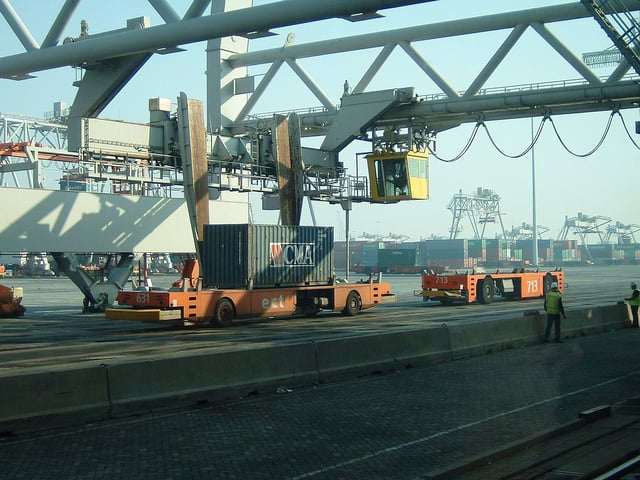
Unmanned vehicles handle containers at Europe Container Terminals (ECT), the largest container terminal operator in Europe.
Rotterdam is the largest port in Europe, with the rivers Meuse and Rhine providing excellent access to the hinterland upstream reaching to Basel, Switzerland and into France. In 2004 Shanghai took over as the world's busiest port. In 2006, Rotterdam was the world's seventh largest container port in terms of twenty-foot equivalent units (TEU) handled.[38]
The port's main activities are petrochemical industries and general cargo handling and transshipment. The harbour functions as an important transit point for bulk materials between the European continent and overseas. From Rotterdam goods are transported by ship, river barge, train or road. In 2007, the Betuweroute, a new fast freight railway from Rotterdam to Germany, was completed.
Shopping
Well-known streets in Rotterdam are the Lijnbaan (the first set of pedestrian streets of the country, opened in 1953), the Hoogstraat, the Coolsingel with the city hall, and the Weena, which runs from the Central Station to the Hofplein (square). A modern shopping venue is the Beurstraverse ("Stock Exchange Traverse"), better known by its informal name 'Koopgoot' ('Buying/Shopping Gutter', after its subterranean position), which crosses the Coolsingel below street level). The Kruiskade is a more upscale shopping street, with retailers like Michael Kors, 7 For All Mankind, Calvin Klein, Hugo Boss, Tommy Hilfiger and the Dutch well known men's clothier Oger. Another upscale shopping venue is a flagship store of department store De Bijenkorf. Located a little more to the east is the Markthal, with lots of small retailers inside. This hall is also one of Rotterdam's famous architectural landmarks.
The main shopping venue in the south of Rotterdam is Zuidplein, which lies close to Rotterdam Ahoy, an accommodation center for shows, exhibitions, sporting events, concerts and congresses. Another prominent shopping center, called Alexandrium, lies in the east of Rotterdam. It includes a large kitchen and furniture center.
Education
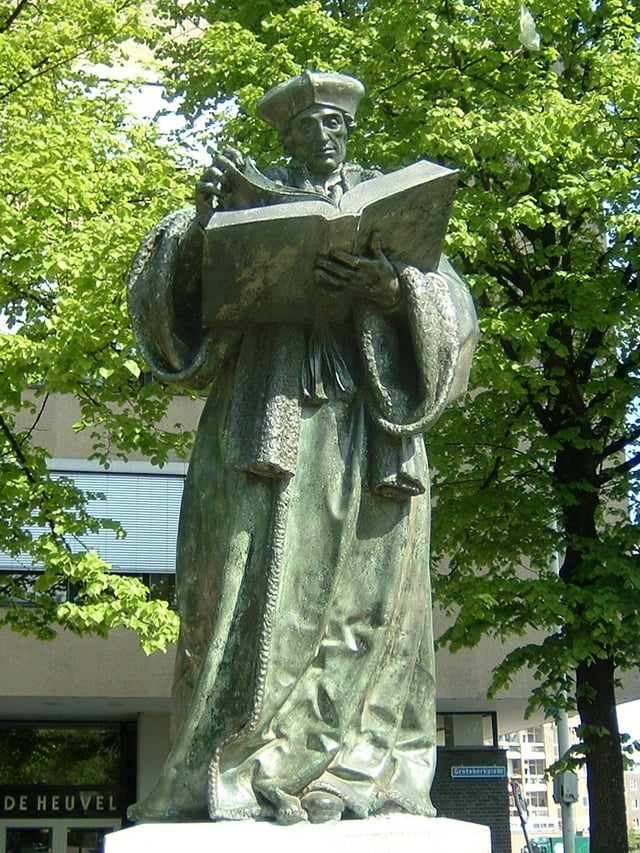
Bronze statue of Erasmus created by Hendrick de Keyser in 1622
Rotterdam has one major university, the Erasmus University Rotterdam (EUR), named after one of the city's famous former inhabitants, Desiderius Erasmus. The Woudestein campus houses (among others) Rotterdam School of Management, Erasmus University. In Financial Times' 2005 rankings it placed 29th globally and 7th in Europe. In the 2009 rankings of Masters of Management, the school reached first place with the CEMS Master in Management and a tenth place with its RSM Master in Management.[39] The university is also home to Europe's largest student association, STAR Study Association Rotterdam School of Management, Erasmus University and the world's largest student association, AIESEC, has its international office in the city.
The Willem de Kooning Academy Rotterdam's main art school, which is part of the Hogeschool Rotterdam. It is regarded as one of the most prestigious art schools in the Netherlands and the number 1 in Advertising and Copywriting. Part of the Willem de Kooning Academy is the Piet Zwart Institute for postgraduate studies and research in Fine Art, Media Design and Retail Design. The Piet Zwart Institute boasts a selective roster of emerging international artists.
The Hoboken campus of EUR houses the Dijkzigt (general) hospital, the Sophia Hospital (for children) and the Medical Department of the University. They are known collectively as the Erasmus Medical Center. This center is ranked third in Europe by CSIC[40] as a hospital, and is also ranked within top 50 universities of the world in the field of medicine (clinical, pre-clinical & health, 2017).[41]
Three Hogescholen (Universities of applied sciences) exist in Rotterdam. These schools award their students a professional Bachelor's degree and postgraduate or Master's degree. The three Hogescholen are Hogeschool Rotterdam, Hogeschool Inholland and Hogeschool voor Muziek en Dans (uni for music and dance) which is also known as CodArts.
As there are many international and American schools scattered across Europe such as ASH (American International School of the Hague) Rotterdam also has its own international/American school by the name AISR (American International School of Rotterdam). At AISR children receive a multicultural education in a culturally diverse community and it offers the International Baccalaureate (IB) Diploma Program.
Unique to the city is the Shipping & Transport College which offers masters, bachelors and vocational diplomas on all levels.
Culture
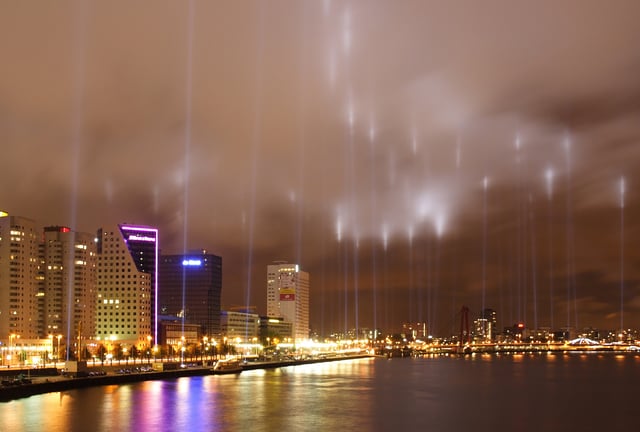
Rotterdam waterfront, with spotlights shining into the air to commemorate the Rotterdam Blitz
Alongside Porto, Rotterdam was European Capital of Culture in 2001. The city has its own orchestra, the Rotterdam Philharmonic, with its well-regarded young music director Yannick Nézet-Séguin; a large congress and concert building called De Doelen; several theaters (including the new Luxor) and movie theatres; and the Rotterdam Ahoy complex in the south of the city, which is used for pop concerts, exhibitions, tennis tournaments, and other activities. A major zoo called Diergaarde Blijdorp is situated at the northwest side of Rotterdam, complete with a walkthrough sea aquarium called the Oceanium.
Rotterdam features some urban architecture projects, nightlife, and many summer festivals celebrating the city's multicultural population and identity, such as the Caribbean-inspired "Summer Carnival", the Dance Parade, Rotterdam 666, the Metropolis pop festival and the World Port days. In the years 2005–2011 the city struggled with venues for popmusic. Many of the venues suffered severe financial problems. This resulted in the disappearance of the major music venues Nighttown and WATT and smaller stages such as Waterfront, Exit, and Heidegger. Currently the city has a few venues for pop music like Rotown, Poortgebouw and Annabel. The venue WORM focuses on experimental music and related cutting edge subcultural music. There are also the International Film Festival in January, the Poetry International Festival in June, the North Sea Jazz Festival in July, the Valery Gergiev Festival in September, September in Rotterdam and the World of the Witte de With. In June 1970, The Holland Pop Festival (which featured Jefferson Airplane, The Byrds, Canned Heat, It's a Beautiful Day, and Santana) was held and filmed at the Stamping Grounds in Rotterdam.
There is a healthy competition with Amsterdam, which is often viewed as the cultural capital of the Netherlands. This rivalry is most common amongst the city's football supporters, Feyenoord (Rotterdam) and Ajax (Amsterdam). There is a saying: "Amsterdam to party, Den Haag (The Hague) to live, Rotterdam to work". Another one, more popular by Rotterdammers, is "Money is earned in Rotterdam, distributed in The Hague and spent in Amsterdam". Another saying that reflects both the rivalry between Rotterdam and Amsterdam is "Amsterdam has it, Rotterdam doesn't need it".
In terms of alternative culture, Rotterdam had from the 1960s until the 2000s a thriving squatters movement which as well as housing thousands of people, occupied venues, social centres and so on.[42] From this movement came clubs like Boogjes, Eksit, Nighttown, Vlerk and Waterfront. The Poortgebouw was squatted in the 1980s and quickly legalised.
Rotterdam is also the home of Gabber, a type of hardcore electronic music popular in the mid-1990s, with hard beats and samples. Groups like Neophyte and Rotterdam Terror Corps (RTC) started in Rotterdam, playing at clubs like Parkzicht.
The main cultural organisations in Amsterdam, such as the Concertgebouw and Holland Festival, have joint forces with similar organisations in Rotterdam, via A'R'dam. In 2007 these organisations published with plans for co-operation.[43] One of the goals is to strengthen the international position of culture and art in the Netherlands in the international context.
On 30 August 2019, it was announced by the European Broadcasting Union and Dutch television broadcasters AVROTROS, NOS & NPO, that Rotterdam will host the Eurovision Song Contest 2020, following the Dutch victory at the 2019 contest in Tel Aviv, Israel with the song "Arcade", performed by Duncan Laurence. The contest will take place at the Rotterdam Ahoy, with the semi-finals taking place on 12 & 14 May 2020 and the final taking place on 16 May 2020. This will be the first time that Rotterdam has hosted the contest, and the first time The Netherlands has hosted the contest since 1980, when it was hosted in The Hague.[44]
Museums
Rotterdam has many museums. Well known museums are the Museum Boijmans Van Beuningen, the Netherlands Architecture Institute, the Wereldmuseum, the Kunsthal, Witte de With Center for Contemporary Art[45] and the Maritime Museum Rotterdam.[46] The Historical Museum Rotterdam has changed into Museum Rotterdam which aims to exhibit Rotterdam as a contemporary transnational city, and not a past city.[47]
Other museums include the tax museum and the natural history museum. At the historical shipyard and museum Scheepswerf 'De Delft', the reconstruction of ship of the line Delft can be visited.[48]
Architecture
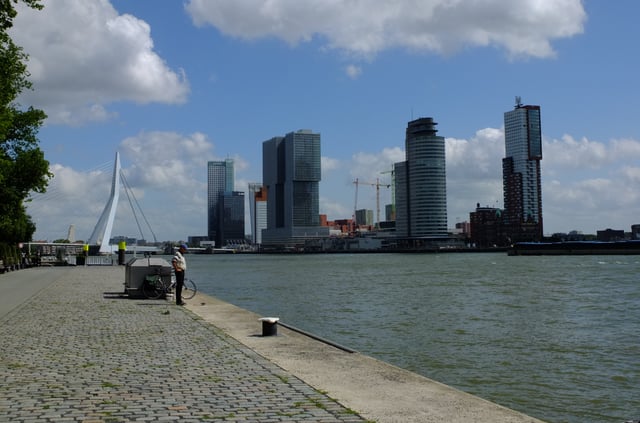
The Wilhelmina pier at the Kop van Zuid in the distance. A part of Rotterdam with many skyscrapers and high-rises. On the left the Erasmus Bridge can be seen.
Rotterdam has become world famous because of its modern and groundbreaking architecture. Throughout the years the city has been nicknamed Manhattan at the Meuse[49][50][51][52][53][54] and The architectural capital of the Netherlands[55][56][57] both for its skyline and because it is home to internationally leading architectural firms involved in the design of famous buildings and bridges in other big cities. Examples include OMA (Rem Koolhaas), Neutelings & Riedijk and Erick van Egeraat.[58][59] It has the reputation in being a platform for architectural development and education through the Berlage Institute, a postgraduate laboratory of architecture, and the NAi (Netherlands Architecture Institute), which is open to the public and has a variety of exhibitions on architecture and urban planning issues. The city has 38 skyscrapers and 352 high-rises and has many skyscrapers planned or under construction.[60][61] The top 5 of highest buildings in the Netherlands consists entirely of buildings in Rotterdam.[62] It is home to the tallest building in the Netherlands, the Maastoren with a height of 165 meters. In 2021, the Zalmhaven Tower will be completed with a height of 212 meters, which will become the new tallest building in the Netherlands.
History
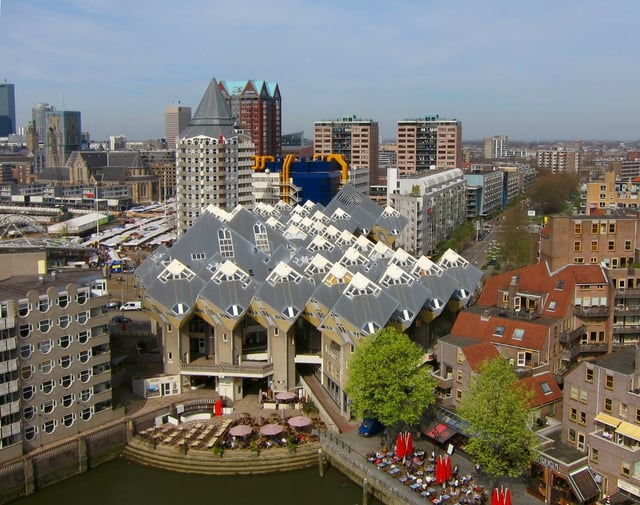
The Cube Houses in 2011
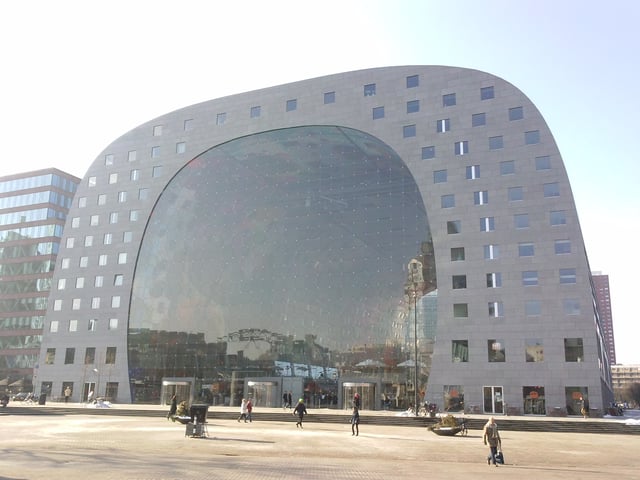
The Markthal as seen from the Binnenrotte, Rotterdam center.

The Euromast in 2005.
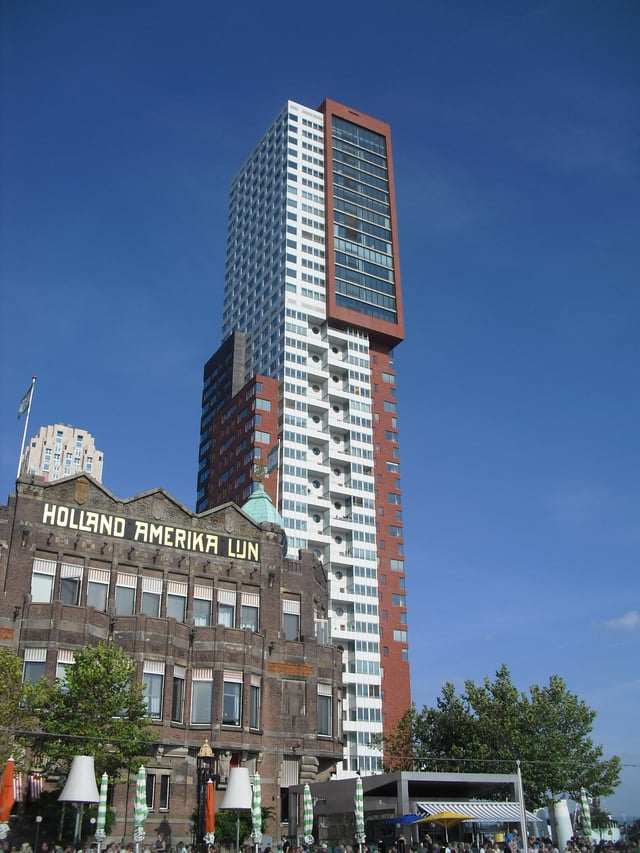
The former headquarters of the Holland America Line next to modern residential architecture in 2010
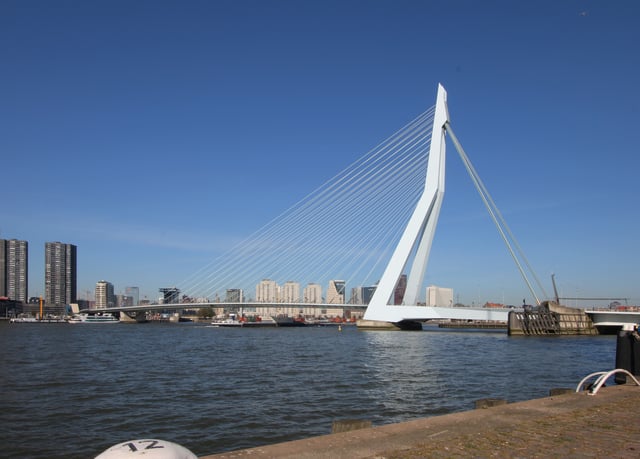
Erasmus Bridge in 2011
In 1898, the 45-metre (148-foot) high-rise office building the White House (in Dutch Witte Huis) was completed, at that time the tallest office building in Europe. In the first decades of the 20th century, some influential architecture in the modern style was built in Rotterdam. Notable are the Van Nelle fabriek (1929) a monument of modern factory design by Brinkman en Van der Vlugt, the Jugendstil clubhouse of the Royal Maas Yacht Club designed by Hooijkaas jr. en Brinkman (1909), and Feyenoord's football stadium De Kuip (1936) also by Brinkman en Van der Vlugt. The architect J. J. P. Oud was a famous Rotterdammer in those days. The Van Nelle Factory obtained the status of UNESCO World Heritage Site in 2014. During the early stages of World War II the center of Rotterdam was bombed by the German Luftwaffe, destroying many of the older buildings in the center of the city. After initial crisis re-construction the center of Rotterdam has become the site of ambitious new architecture.
Rotterdam is also famous for its Lijnbaan 1952 by architects Broek en Bakema, Peperklip by architect Carel Weeber, Kubuswoningen or cube houses designed by architect Piet Blom 1984.
The newest landmark in Rotterdam is the Markthal, designed by architect firm MVRDV. In addition to that there are many international well known architects based in Rotterdam like O.M.A (Rem Koolhaas), Neutelings & Riedijk and Erick van Egeraat to name a few. Two architectural landmarks are located in the Lloydkwartier: the STC college building and the Schiecentrale 4b.
Rotterdam also houses several of the tallest structures in the Netherlands.
The Erasmusbrug (1996) is a 790-meter (2,600 ft) cable stayed bridge linking the north and south of Rotterdam. It is held up by a 138 metres (453 ft) tall pylon with a characteristic bend, earning the bridge its nickname 'De Zwaan' ('the Swan').
Rotterdam has the tallest residential building in the Netherlands: the New Orleans Tower (158.35 metres (519.5 ft)).
Rotterdam is also home to the tallest office building 'Maastoren' (164.75 m or 540.5 ft) which houses Deloitte. This office tower surpassed the 'Delftse Poort' (160 m or 520 ft) which houses Nationale-Nederlanden insurance company, part of ING Group as tallest office tower in 2009.[63][64]
The city also houses the 186 metres (610 ft) tall Euromast, which is a major tourist attraction. It was built in 1960, initially reaching a height of 101 metres (331 ft); in 1970, the Euromast was extended by 85 metres (279 ft) to its current height.
Rotterdam has a reputation in being a platform for architectural development and education through the Berlage Institute, a postgraduate laboratory of architecture, and the NAi (Netherlands Architecture Institute), which is open to the public and has a variety of good exhibitions on architecture and urban planning issues.
Over 30 new highrise projects are being developed at the moment. A Guardian journalist wrote in 2013 that "All this is the consequence of the city suffering a bombardment of two things: bombs and architects."[24]
Highrise buildings that are currently being built:
Zalmhaventoren, with a height of 215 metres (705 feet) the highest building in the Netherlands when completed. The tower is expected to be completed in 2021.
Sports
Rotterdam calls itself Sportstad (City of Sports). The city annually organises several world-renowned sporting events. Some examples are the Rotterdam Marathon, the World Port Tournament, and the Rotterdam World Tennis Tournament. Rotterdam also organises one race of the Red Bull Air Race World Championship and the car racing event Monaco aan de Maas (Monaco at the Meuse).
The city is also the home of many sports clubs and some historic and iconic athletes.
Football
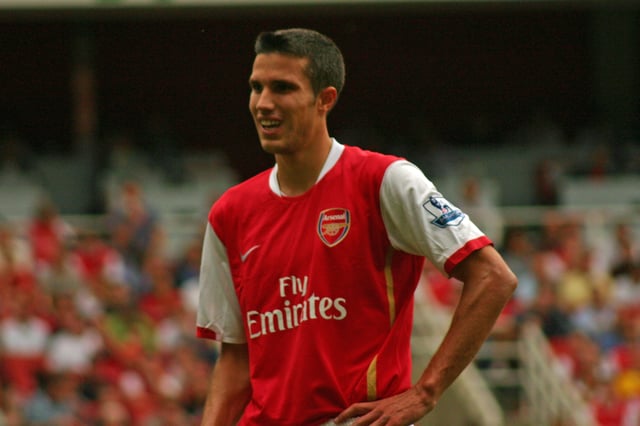
Robin van Persie began his career with SBV Excelsior and broke through in Feyenoord.
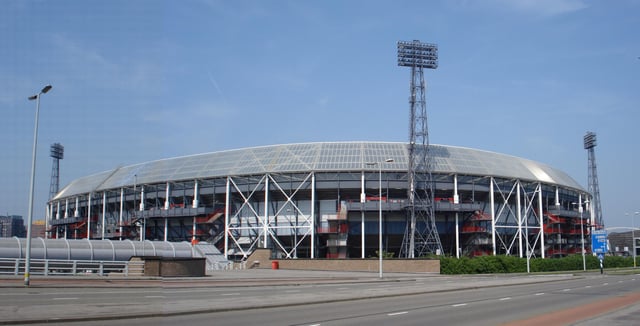
De Kuip, Feyenoord home stadium.
Rotterdam is the home of three professional football clubs, being first tier clubs Feyenoord and Sparta and second tier club Excelsior.
Feyenoord, founded in 1908 and the dominant of the three professional clubs, has won fifteen national titles since the introduction of professional football in the Netherlands. It won the European Cup (current Champions league) as the first Dutch club in 1970, and won the World Cup for club teams in the same year. In 1974, they were the first Dutch club to win the UEFA Cup and in 2002, Feyenoord won the UEFA Cup again. In 2008, the year of their 100-year-anniversary, Feyenoord won the KNVB-cup.
Seating 51,480, its 1937 stadium, called Stadion Feijenoord but popularly known as De Kuip ('the Tub'), is the second largest in the country, after the Amsterdam Arena. De Kuip, located in the southeast of the city, has hosted many international football games, including the final of Euro 2000 and has been awarded a FIFA 5 star ranking. There are concrete plans to build a new stadium with a capacity of at least 63,000 seats.
Sparta, founded in 1888 and situated in the northwest of Rotterdam, won the national title six times; Excelsior (founded 1902), in the northeast, has never won any.
Rotterdam also has three fourth tier clubs, SC Feijenoord (Feyenoord Amateurs), PVV DOTO and TOGR. Rotterdam is and has been the home to many great football players and coaches, among whom:
Bert van Marwijk
Coen Moulijn
Dirk Kuyt
Ernst Happel
Faas Wilkes
Giovanni van Bronckhorst
Georginio Wijnaldum
Henrik Larsson
Danny Blind
John de Wolf
Jon Dahl Tomasson
Leo Beenhakker
Louis van Gaal
Ove Kindvall
Kevin Strootman
Memphis Depay
Pierre van Hooijdonk
Pim Doesburg
Puck van Heel
Rinus Israël
Robin van Persie
Ronald Koeman
Roy Makaay
Ruud Gullit
Sonny Silooy
Willem van Hanegem
Wim Jansen
Winston Bogarde
Włodzimierz Smolarek
Marathon
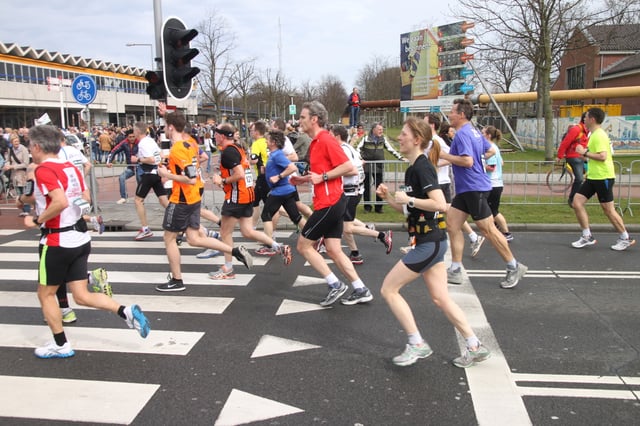
Runners during the marathon in Rotterdam
Rotterdam has its own annual international marathon, which offers one of the fastest courses in the world. From 1985 until 1998, the world record was set in Rotterdam, first by Carlos Lopes and later in 1988 by Belayneh Densamo.
In 1998, the world record for women was set by Tegla Loroupe, in a time of 2:20.47. Loroupe won the Rotterdam Marathon three consecutive times, from 1997 to 1999.
The current track record for men is held by Duncan Kibet, who ran a time of 2:04.27 in 2009. The female record was set in 2012, when Tiki Gelana finished the race in 2:18.58. Gelana went on to become the 2012 Olympic champion in London, a few months later.
The marathon starts and ends on the Coolsingel in the heart of Rotterdam. It attracts a total of 900.000 visitors.
Tennis

Arthur Ashe at the 1975 ABN World Tennis Tournament
Since 1972, Rotterdam hosts the indoor hard court ABN AMRO World Tennis Tournament, part of the ATP Tour. The event was first organised in 1972, when it was won by Arthur Ashe. Ashe went on to win the tournament two more times, making him the singles title record holder.
Former Wimbledon winner Richard Krajicek became the tournament director after his retirement in 2000. The latest edition of the tournament attracted a total of 116.354 visitors.[65]
Tour de France
In November 2008 Rotterdam was chosen as the host of the Grand Départ of the 2010 Tour de France. Rotterdam won the selection over the Dutch city of Utrecht. Germany's Düsseldorf had previously also expressed interest in hosting. The Amaury Sport Organization (ASO), organizer of the Tour de France, said in a statement on its web site that it chose Rotterdam because, in addition to it being another big city, like London, to showcase the use of bikes for urban transportation, it provided a location well positioned considering the rest of the route envisioned for the 2010 event.
The start in Rotterdam was the fifth in the Netherlands. The prologue was a 7 km (4.35 mi) individual time trial crossing the centre of the city. The first regular stage left the Erasmusbrug and went south, towards Brussels.
The second stage of 2015 edition took the riders through Rotterdam on their way to Neeltje Jans in Zeeland.
Rowing
Members of the student rowing club Skadi were part of the 'Holland Acht', winning a gold medal at the Olympics in 1996.. Since the opening in April 2013, Rotterdam hosts the rowing venue Willem-Alexander Baan that hosted the 2016 World Rowing Championships for Seniors, U23 and Juniors.
Field hockey
In field hockey, Rotterdam has the largest hockey club in the Netherlands, HC Rotterdam, with its own stadium in the north of the city and nearly 2,400 members. The first men's and women's teams both play on the highest level in the Dutch Hoofdklasse.
Baseball
Rotterdam is home to the most successful European baseball team, Neptunus Rotterdam, winning the most European Cups.
Boxing
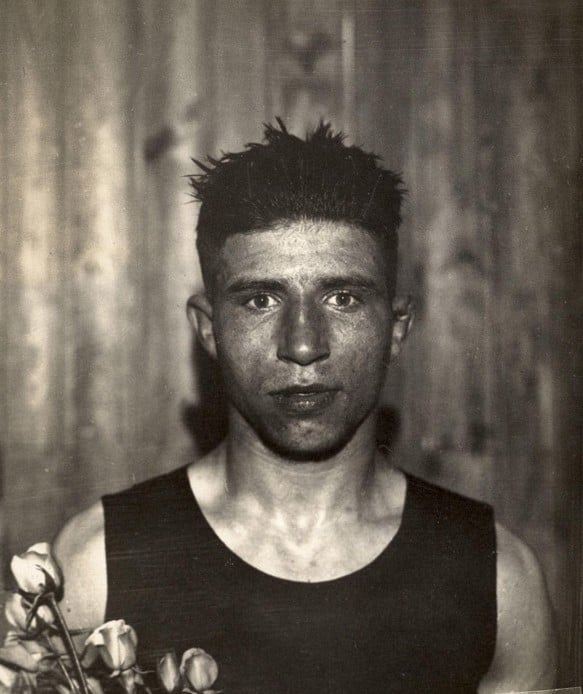
Bep van Klaveren
Rotterdam has a long boxing tradition starting with Bep van Klaveren (1907–1992), aka 'The Dutch Windmill', Gold medal winner of the 1928 Amsterdam Olympics, followed by professional boxers like Regilio Tuur and Don Diego Poeder.
Swimming
Rotterdam's swimming tradition started with Marie Braun aka Zus (sister) Braun, who was coached to a Gold medal at the 1928 Amsterdam Olympics by her mother Ma Braun, and 3 European titles 3 years later in Paris. In her career as 14 time national champ, she broke 6 world records. Ma Braun later also coached the Rotterdam born, three-times Olympic champion Rie Mastenbroek during the Berlin Olympics in 1936. In later years Inge de Bruijn became a Rotterdam sport icon as triple Olympic Gold medal winner in 2000 and triple European Gold medal winner in 2001.
Motor cycle racing
Motor cycle speedway was staged in the Feyenoord Stadium after the second world war. The team which raced in a Dutch league was known as the Feyenoord Tigers. The team included Dutch riders and some English and Australian riders.
Sportsmen of the year election
Since 1986, the city has selected its best sportsman, woman and team at the Rotterdam Sports Awards Election, held in December.
Other famous Rotterdam athletes

Francisco Elson
Mia Audina, a retired Indonesia born badminton player, living in Rotterdam.
Nelli Cooman, a Surinamese born retired athlete who held the 60 m dash world record, and was the world and European champion in that event.
Robert Doornbos, a Rotterdam born race car driver, who competed in the Formula One.
Robert Eenhoorn, a Rotterdam born retired MLB short stop, who competed for the New York Yankees, the Anaheim Angels and the New York Mets.
Dex Elmont, a Rotterdam born judoka, who finished second in the European championships in 2009 in the 65 to 73 kg (143 to 161 lb) division.
Guillaume Elmont, a Rotterdam born judoka, who became world champion in 2005 in the 73 to 81 kg (161 to 179 lb) division.
Francisco Elson, a Rotterdam born basketball player who played in the NBA, won the NBA finals in 2007 with the San Antonio Spurs.
Ignisious Gaisah, a Ghanaian born long jumper with a personal best of 8.43 metres (27.66 feet), residing in Rotterdam since 2001. Gaisah is a multiple medal winner in several international events, both as a citizen of Ghana and the Netherlands.
Francis Hoenselaar, a Rotterdam born female darts player, generally recognised as the best Dutch female darts player ever.
Robert Lathouwers, an athlete born in a Rotterdam suburb, specialised in the 800 m. Lathouwers gained international notoriety when he got disqualified after shoving Irish athlete David McCarthy in the 2010 European Championships.
Fatima Moreira de Melo, a Rotterdam born, three-times olympic champion in field hockey. Moreira de Melo currently is a professional poker player.
Piet Roozenburg, a Rotterdam born draughts player, who was the world champion from 1948 to 1956 and the 8-time Dutch champion.
Betty Stöve, a Rotterdam born retired female tennis double specialist and 10-time Grand Slam winner.
Ingmar Vos, a Rotterdam born decathlete, with a personal best of 8224 points.
Yearly events
Rotterdam hosts several annual events unique to the city. It hosts the Zomercarnaval (Summercarnaval), the second largest Caribbean carnival in Europe, originally called the Antillean carnival. Other events include: North Sea Jazz Festival, the largest Jazz festival in Europe, Bavaria City Race, a Formula 1 race inside the city center and a 3 day long maritime extravaganza called the World Port Days celebrating the Port of Rotterdam.
January: "Zesdaagse van Rotterdam" "(six-day track-cycling race) – Rotterdam Ahoy
January: International Film Festival Rotterdam[66]
February: Rotterdam Open ABM AMRO ATP 500 Tennis Tournament – Rotterdam Ahoy
April–June: Rotterdam Marathon[67] Koningsdag Festival (27 April)[68]
July: North Sea Jazz Festival (second weekend of July) Summer Carnival[69]
August: Bavaria City Race Pleinbioscoop[70] Dag van de Romantische Muziek (Romantic music festival)
September: The World Port Days[71]
Transportation
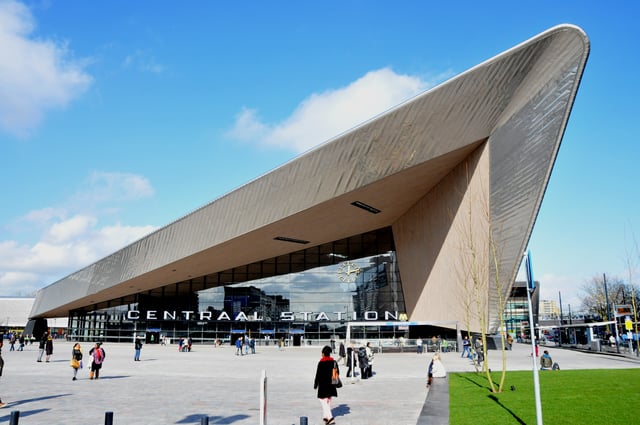
Rotterdam's new Central Station reopened in March 2014, designed to handle up to 320,000 passengers daily.

Map of Rotterdam Metro
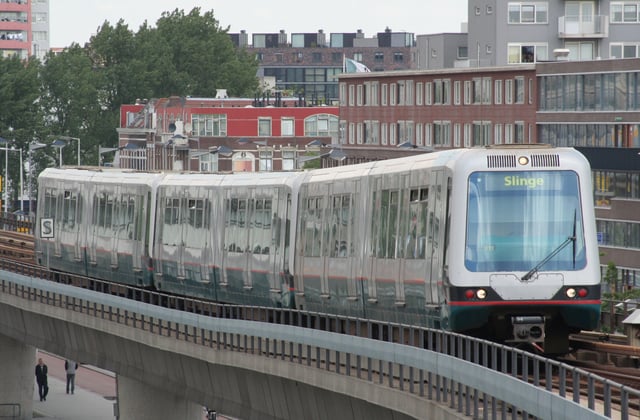
Rotterdam metro

A Citadis tram outside the former Rotterdam Centraal, 2008
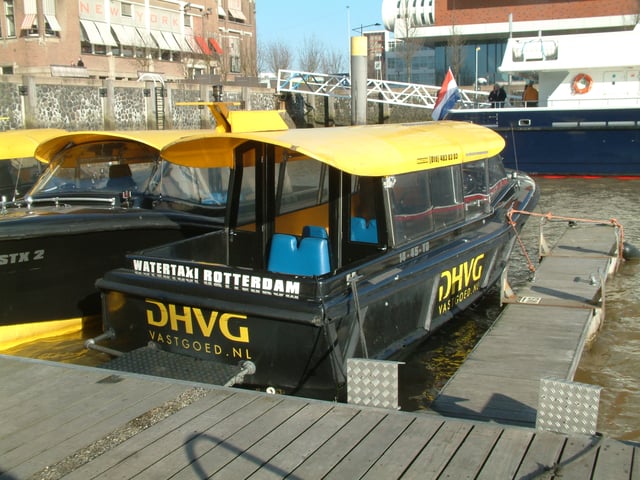
Water Taxi in Rotterdam
Rotterdam offers connections by international, national, regional and local public transport systems, as well as by the Dutch motorway network.
Motorways There are several motorways to/from Rotterdam. The following four are part of its 'Ring' (ring road):
A20 (Ring North): Hoek van Holland – Rotterdam – Gouda
A16 (Ring East): Rotterdam – Breda (- Antwerp – Paris)
A15 (Ring South): Europoort – Rotterdam – Nijmegen
A4 (Ring West). Rotterdam - The Hague (- Amsterdam)
The following two other motorways also serve Rotterdam:
A13, (Amsterdam -) The Hague – Delft – Rotterdam
A29, (Antwerp -) Bergen op Zoom – Rotterdam
Airport Much smaller than the international hub Schiphol Airport, Rotterdam The Hague Airport (formerly known as Zestienhoven) is the third largest airport in the country, behind Schiphol Airport and Eindhoven Airport. Located north of the city, it has shown a very strong growth over the past five years, mostly caused by the growth of the low-cost carrier market. For business travelers, Rotterdam The Hague Airport offers advantages in terms of rapid handling of passengers and baggage. Environmental regulations make further growth uncertain.
Train
Rotterdam is well connected to the Dutch railway network, and has several international connections:
Southern direction Dordrecht, Breda, Eindhoven, Flushing (Vlissingen) (also international trains to Belgium/France)
Western direction Hoek van Holland
North-Western direction The Hague, Leiden, Amsterdam
Northern direction (high-speed rail) Schiphol, Amsterdam
North-Eastern direction Utrecht and further
A fifth alternative train system to the Hague, the Hofplein Line was converted to the light rail system Randstadrail in 2006.
The city is often mentioned as the terminus of the Eurasian Land Bridge.
Railway stations
Rotterdam Centraal – Rotterdam's main station
Rotterdam Alexander – Eastern part of Rotterdam
Rotterdam Blaak – Close to the centre of Rotterdam
Rotterdam Lombardijen – Most Southern part of Rotterdam
Rotterdam Noord – Northern part of Rotterdam
Rotterdam Zuid – Northern part of the Southern part of Rotterdam
Rotterdam Stadion – A station near the Feyenoord stadium, open in connection with football matches and music concerts
The main connections:
Direct international services to Belgium and France via high speed train system: Thalys
Frequent international trains to Antwerp and Brussels, Belgium
Frequent services within the Netherlands: Intercity line to The Hague, Leiden, Schiphol airport and Amsterdam (north) Intercity line to Utrecht and on to Deventer or Enschede (the east), Leeuwarden (north-west) or Groningen (north-east) Intercity line to Dordrecht, Roosendaal and on to Vlissingen (south west) Intercity line to Dordrecht, Breda, Tilburg, Eindhoven and Venlo (south east) Night services every hour connecting every day of the week to Delft, The Hague, Leiden, Schiphol airport, Amsterdam, and, with a detour, Utrecht. On Thursday, Friday and Saturday night services (either direct or via a detour) to Den Bosch, Eindhoven, Tilburg, Roosendaal. Several semi-fast services and local trains originate or call at Rotterdam Centraal; semi-fast services Amsterdam-Breda.
Detailed information available from the site of the Nederlandse Spoorwegen (Dutch Railways)[72]
In Rotterdam, public transport services are provided by the following companies:
NS (Dutch Railways): national train services
RET (Rotterdamse Elektrische Tram): Tram, city-bus, metro, randstadrail and ferry-services in Rotterdam and surrounding cities
Arriva Netherlands: regional bus services
Connexxion: regional bus services
Veolia: regional bus services.
Metro
In 1968, Rotterdam was the first Dutch city to open a metro system. Currently the metro system consists of three main lines, each of which has its own variants. The metro network has 78.3 km (48.7 mi) of railtracks and there are 62 stations, which makes it the biggest of the Benelux. The system is operated by 5 lines; 3 lines (A, B and C) on the east-west line, and two (D and E) on the north-south line. Line E (Randstadrail) connects Rotterdam with The Hague as of December 2011.
| Line | Southern / western terminus | Northern / eastern terminus |
|---|---|---|
| Line A | Schiedam Centrum | Binnenhof |
| Line B | Schiedam Centrum | Nesselande |
| Line C | De Akkers | De Terp |
| Line D | De Akkers | Rotterdam Centraal |
| Line E | Slinge | Den Haag Centraal |
Tram
The Rotterdam tramway network offers 9 regular tram lines and 4 special tram lines with a total length of 93.4 km (58.0 mi). Service Tramlines in Rotterdam as of 2016:
2: (Rotterdam) Charlois – Rotterdam Lombardijen NS – (Rotterdam) Keizerswaard (runs only to the southern part of the city)
4: (Rotterdam) Molenlaan – Rotterdam Centraal – (Rotterdam) Marconiplein
7: (Rotterdam) Oostplein – Rotterdam Centraal – (Rotterdam) Willemsplein
8: (Rotterdam) Spangen – Rotterdam Centraal – (Rotterdam) Kleiweg
20: Rotterdam Centraal – Rotterdam Lombardijen NS – (Rotterdam) Lombardijen
21: (Schiedam) Woudhoek – Station Schiedam Centrum – Rotterdam Centraal – (Rotterdam) De Esch
23: (Rotterdam) Marconiplein – Rotterdam Centraal – (Rotterdam) Beverwaard
24: (Vlaardingen) Holy – Station Schiedam Centrum – Rotterdam Centraal – (Rotterdam) De Esch
25: (Rotterdam) Schiebroek – Rotterdam Centraal – (Barendrecht) Carnisselande
Special tram lines:
10: Historical tram line, only runs in summer and throughout the whole city for tourist information. Using historical Rotterdam Trams from the year 1931.
18: Tramline from Rotterdam Central Station towards Park, runs only at the Dunya Festival and during the Rotterdam World Port Days.
12: Rotterdam Centraal – Stadion Feyenoord or Rotterdam Centraal – Het Kasteel ('The Castle', Sparta Stadium). Football tramline, only for big fixtures at Stadion Feyenoord or Het Kasteel.
Snert-tram: Historical tram, only in winter as a tourist tram through Rotterdam. Passengers are provided with a cup of "snert"; Rotterdam dialect for erwtensoep (pea soup). Rolling stock is a historical Rotterdam tram from 1968.
IJsjes-tram: Summer version of the snert tram, providing tourists with ijsjes (ice cream) rather than snert.
Bus Rotterdam offers 55 city bus lines with a total length of 432.7 km (268.9 mi).
RET runs buses in the city of Rotterdam and surrounding places like Spijkenisse, Barendrecht, Ridderkerk, Rhoon, Poortugaal, Schiedam, Vlaardingen, Delft and Capelle aan den IJssel. .
Arriva Netherlands, Connexxion and Veolia run buses from other cities to Rotterdam.
Waterbus The Waterbus network consists of seven lines. The main line (Line 20) stretches from Rotterdam to Dordrecht. The ferry carries about 130 passengers and there is space for 60 bicycles. The stops between Rotterdam and Dordrecht are:
Rotterdam Erasmusbrug – Krimpen aan den IJssel Stormpolder – Ridderkerk De Schans – Alblasserdam Kade – Hendrik-Ido-Ambacht Noordeinde – Papendrecht Westeind – Dordrecht Merwekade.
International relations
Rotterdam has city and port connections throughout the world. In 2008, the city had 13 sister cities, 12 partner cities, and 4 sister ports.[73] Since 2008, the City of Rotterdam doesn't forge new sister or partner connections. Sister and partner cities are not a priority in international relations.[74]
On 15 March 2017 the Turkish president expressed his wish that Istanbul should no longer be the twin town of Rotterdam. A speaker of the Rotterdam municipality then explained that the two cities have no official partnership. Both authorities do cooperate often.[75]
Twin towns – Sister cities
Rotterdam is twinned with:
[[INLINE_IMAGE|//upload.wikimedia.org/wikipedia/en/thumb/a/a4/Flag_of_the_United_States.svg/23px-Flag_of_the_United_States.svg.png|//upload.wikimedia.org/wikipedia/en/thumb/a/a4/Flag_of_the_United_States.svg/35px-Flag_of_the_United_States.svg.png 1.5x, //upload.wikimedia.org/wikipedia/en/thumb/a/a4/Flag_of_the_United_States.svg/46px-Flag_of_the_United_States.svg.png 2x|United States|h12|w23|thumbborder flagicon-img flagicon-img]] Baltimore (since 1985)[73][76]
[[INLINE_IMAGE|//upload.wikimedia.org/wikipedia/commons/thumb/9/9a/Flag_of_Bulgaria.svg/23px-Flag_of_Bulgaria.svg.png|//upload.wikimedia.org/wikipedia/commons/thumb/9/9a/Flag_of_Bulgaria.svg/35px-Flag_of_Bulgaria.svg.png 1.5x, //upload.wikimedia.org/wikipedia/commons/thumb/9/9a/Flag_of_Bulgaria.svg/46px-Flag_of_Bulgaria.svg.png 2x|Bulgaria|h14|w23|thumbborder flagicon-img flagicon-img]] Burgas (since 1976)[73][76]
[[INLINE_IMAGE|//upload.wikimedia.org/wikipedia/en/thumb/b/ba/Flag_of_Germany.svg/23px-Flag_of_Germany.svg.png|//upload.wikimedia.org/wikipedia/en/thumb/b/ba/Flag_of_Germany.svg/35px-Flag_of_Germany.svg.png 1.5x, //upload.wikimedia.org/wikipedia/en/thumb/b/ba/Flag_of_Germany.svg/46px-Flag_of_Germany.svg.png 2x|Germany|h14|w23|thumbborder flagicon-img flagicon-img]] Cologne (since 1958)[73][76]
[[INLINE_IMAGE|//upload.wikimedia.org/wikipedia/commons/thumb/7/73/Flag_of_Romania.svg/23px-Flag_of_Romania.svg.png|//upload.wikimedia.org/wikipedia/commons/thumb/7/73/Flag_of_Romania.svg/35px-Flag_of_Romania.svg.png 1.5x, //upload.wikimedia.org/wikipedia/commons/thumb/7/73/Flag_of_Romania.svg/45px-Flag_of_Romania.svg.png 2x|Romania|h15|w23|thumbborder flagicon-img flagicon-img]] Constanța (since 1976)[73][76]
[[INLINE_IMAGE|//upload.wikimedia.org/wikipedia/en/thumb/b/ba/Flag_of_Germany.svg/23px-Flag_of_Germany.svg.png|//upload.wikimedia.org/wikipedia/en/thumb/b/ba/Flag_of_Germany.svg/35px-Flag_of_Germany.svg.png 1.5x, //upload.wikimedia.org/wikipedia/en/thumb/b/ba/Flag_of_Germany.svg/46px-Flag_of_Germany.svg.png 2x|Germany|h14|w23|thumbborder flagicon-img flagicon-img]] Dresden (since 1988)[73][76]
[[INLINE_IMAGE|//upload.wikimedia.org/wikipedia/commons/thumb/d/da/Flag_of_Luxembourg.svg/23px-Flag_of_Luxembourg.svg.png|//upload.wikimedia.org/wikipedia/commons/thumb/d/da/Flag_of_Luxembourg.svg/35px-Flag_of_Luxembourg.svg.png 1.5x, //upload.wikimedia.org/wikipedia/commons/thumb/d/da/Flag_of_Luxembourg.svg/46px-Flag_of_Luxembourg.svg.png 2x|Luxembourg|h14|w23|thumbborder flagicon-img flagicon-img]] Esch-sur-Alzette (since 1958)[73][76]
[[INLINE_IMAGE|//upload.wikimedia.org/wikipedia/en/thumb/1/12/Flag_of_Poland.svg/23px-Flag_of_Poland.svg.png|//upload.wikimedia.org/wikipedia/en/thumb/1/12/Flag_of_Poland.svg/35px-Flag_of_Poland.svg.png 1.5x, //upload.wikimedia.org/wikipedia/en/thumb/1/12/Flag_of_Poland.svg/46px-Flag_of_Poland.svg.png 2x|Poland|h14|w23|thumbborder flagicon-img flagicon-img]] Gdańsk (since 1977)[73][76]
[[INLINE_IMAGE|//upload.wikimedia.org/wikipedia/commons/thumb/b/bd/Flag_of_Cuba.svg/23px-Flag_of_Cuba.svg.png|//upload.wikimedia.org/wikipedia/commons/thumb/b/bd/Flag_of_Cuba.svg/35px-Flag_of_Cuba.svg.png 1.5x, //upload.wikimedia.org/wikipedia/commons/thumb/b/bd/Flag_of_Cuba.svg/46px-Flag_of_Cuba.svg.png 2x|Cuba|h12|w23|thumbborder flagicon-img flagicon-img]] Havana (since 1983)[73][76]
[[INLINE_IMAGE|//upload.wikimedia.org/wikipedia/en/thumb/c/c3/Flag_of_France.svg/23px-Flag_of_France.svg.png|//upload.wikimedia.org/wikipedia/en/thumb/c/c3/Flag_of_France.svg/35px-Flag_of_France.svg.png 1.5x, //upload.wikimedia.org/wikipedia/en/thumb/c/c3/Flag_of_France.svg/45px-Flag_of_France.svg.png 2x|France|h15|w23|thumbborder flagicon-img flagicon-img]] Lille (since 1958)[73][76]
[[INLINE_IMAGE|//upload.wikimedia.org/wikipedia/commons/thumb/9/92/Flag_of_Belgium_%28civil%29.svg/23px-Flag_of_Belgium_%28civil%29.svg.png|//upload.wikimedia.org/wikipedia/commons/thumb/9/92/Flag_of_Belgium_%28civil%29.svg/35px-Flag_of_Belgium_%28civil%29.svg.png 1.5x, //upload.wikimedia.org/wikipedia/commons/thumb/9/92/Flag_of_Belgium_%28civil%29.svg/45px-Flag_of_Belgium_%28civil%29.svg.png 2x|Belgium|h15|w23|thumbborder flagicon-img flagicon-img]] Liège (since 1958)[73][76]
[[INLINE_IMAGE|//upload.wikimedia.org/wikipedia/commons/thumb/f/fa/Flag_of_the_People%27s_Republic_of_China.svg/23px-Flag_of_the_People%27s_Republic_of_China.svg.png|//upload.wikimedia.org/wikipedia/commons/thumb/f/fa/Flag_of_the_People%27s_Republic_of_China.svg/35px-Flag_of_the_People%27s_Republic_of_China.svg.png 1.5x, //upload.wikimedia.org/wikipedia/commons/thumb/f/fa/Flag_of_the_People%27s_Republic_of_China.svg/45px-Flag_of_the_People%27s_Republic_of_China.svg.png 2x|China|h15|w23|thumbborder flagicon-img flagicon-img]] Shanghai (since 1979)[73][76]
[[INLINE_IMAGE|//upload.wikimedia.org/wikipedia/en/thumb/f/f3/Flag_of_Russia.svg/23px-Flag_of_Russia.svg.png|//upload.wikimedia.org/wikipedia/en/thumb/f/f3/Flag_of_Russia.svg/35px-Flag_of_Russia.svg.png 1.5x, //upload.wikimedia.org/wikipedia/en/thumb/f/f3/Flag_of_Russia.svg/45px-Flag_of_Russia.svg.png 2x|Russia|h15|w23|thumbborder flagicon-img flagicon-img]] Saint Petersburg (since 1984)[73][76]
[[INLINE_IMAGE|//upload.wikimedia.org/wikipedia/en/thumb/0/03/Flag_of_Italy.svg/23px-Flag_of_Italy.svg.png|//upload.wikimedia.org/wikipedia/en/thumb/0/03/Flag_of_Italy.svg/35px-Flag_of_Italy.svg.png 1.5x, //upload.wikimedia.org/wikipedia/en/thumb/0/03/Flag_of_Italy.svg/45px-Flag_of_Italy.svg.png 2x|Italy|h15|w23|thumbborder flagicon-img flagicon-img]] Turin (since 1958)[73][76]
Partner cities
[[INLINE_IMAGE|//upload.wikimedia.org/wikipedia/commons/thumb/9/92/Flag_of_Belgium_%28civil%29.svg/23px-Flag_of_Belgium_%28civil%29.svg.png|//upload.wikimedia.org/wikipedia/commons/thumb/9/92/Flag_of_Belgium_%28civil%29.svg/35px-Flag_of_Belgium_%28civil%29.svg.png 1.5x, //upload.wikimedia.org/wikipedia/commons/thumb/9/92/Flag_of_Belgium_%28civil%29.svg/45px-Flag_of_Belgium_%28civil%29.svg.png 2x|Belgium|h15|w23|thumbborder flagicon-img flagicon-img]] Antwerp (since 1940)[73]
[[INLINE_IMAGE|//upload.wikimedia.org/wikipedia/commons/thumb/f/f3/Flag_of_Switzerland.svg/16px-Flag_of_Switzerland.svg.png|//upload.wikimedia.org/wikipedia/commons/thumb/f/f3/Flag_of_Switzerland.svg/24px-Flag_of_Switzerland.svg.png 1.5x, //upload.wikimedia.org/wikipedia/commons/thumb/f/f3/Flag_of_Switzerland.svg/32px-Flag_of_Switzerland.svg.png 2x|Switzerland|h16|w16|thumbborder flagicon-img flagicon-img]] Basel (since 1945)[73]
[[INLINE_IMAGE|//upload.wikimedia.org/wikipedia/commons/thumb/e/e6/Flag_of_Slovakia.svg/23px-Flag_of_Slovakia.svg.png|//upload.wikimedia.org/wikipedia/commons/thumb/e/e6/Flag_of_Slovakia.svg/35px-Flag_of_Slovakia.svg.png 1.5x, //upload.wikimedia.org/wikipedia/commons/thumb/e/e6/Flag_of_Slovakia.svg/45px-Flag_of_Slovakia.svg.png 2x|Slovakia|h15|w23|thumbborder flagicon-img flagicon-img]] Bratislava (since 1991)[73]
[[INLINE_IMAGE|//upload.wikimedia.org/wikipedia/commons/thumb/c/c1/Flag_of_Hungary.svg/23px-Flag_of_Hungary.svg.png|//upload.wikimedia.org/wikipedia/commons/thumb/c/c1/Flag_of_Hungary.svg/35px-Flag_of_Hungary.svg.png 1.5x, //upload.wikimedia.org/wikipedia/commons/thumb/c/c1/Flag_of_Hungary.svg/46px-Flag_of_Hungary.svg.png 2x|Hungary|h12|w23|thumbborder flagicon-img flagicon-img]] Budapest (since 1991)[73]
[[INLINE_IMAGE|//upload.wikimedia.org/wikipedia/en/thumb/b/ba/Flag_of_Germany.svg/23px-Flag_of_Germany.svg.png|//upload.wikimedia.org/wikipedia/en/thumb/b/ba/Flag_of_Germany.svg/35px-Flag_of_Germany.svg.png 1.5x, //upload.wikimedia.org/wikipedia/en/thumb/b/ba/Flag_of_Germany.svg/46px-Flag_of_Germany.svg.png 2x|Germany|h14|w23|thumbborder flagicon-img flagicon-img]] Duisburg (since 1950)[73]
[[INLINE_IMAGE|//upload.wikimedia.org/wikipedia/commons/thumb/a/af/Flag_of_South_Africa.svg/23px-Flag_of_South_Africa.svg.png|//upload.wikimedia.org/wikipedia/commons/thumb/a/af/Flag_of_South_Africa.svg/35px-Flag_of_South_Africa.svg.png 1.5x, //upload.wikimedia.org/wikipedia/commons/thumb/a/af/Flag_of_South_Africa.svg/45px-Flag_of_South_Africa.svg.png 2x|South Africa|h15|w23|thumbborder flagicon-img flagicon-img]] Durban (since 1991)[73]
[[INLINE_IMAGE|//upload.wikimedia.org/wikipedia/en/thumb/a/ae/Flag_of_the_United_Kingdom.svg/23px-Flag_of_the_United_Kingdom.svg.png|//upload.wikimedia.org/wikipedia/en/thumb/a/ae/Flag_of_the_United_Kingdom.svg/35px-Flag_of_the_United_Kingdom.svg.png 1.5x, //upload.wikimedia.org/wikipedia/en/thumb/a/ae/Flag_of_the_United_Kingdom.svg/46px-Flag_of_the_United_Kingdom.svg.png 2x|United Kingdom|h12|w23|thumbborder flagicon-img flagicon-img]] Hull (since 1936)[73]
[[INLINE_IMAGE|//upload.wikimedia.org/wikipedia/commons/thumb/9/9f/Flag_of_Indonesia.svg/23px-Flag_of_Indonesia.svg.png|//upload.wikimedia.org/wikipedia/commons/thumb/9/9f/Flag_of_Indonesia.svg/35px-Flag_of_Indonesia.svg.png 1.5x, //upload.wikimedia.org/wikipedia/commons/thumb/9/9f/Flag_of_Indonesia.svg/45px-Flag_of_Indonesia.svg.png 2x|Indonesia|h15|w23|thumbborder flagicon-img flagicon-img]] Jakarta (since 1983)[73]
[[INLINE_IMAGE|//upload.wikimedia.org/wikipedia/en/thumb/b/ba/Flag_of_Germany.svg/23px-Flag_of_Germany.svg.png|//upload.wikimedia.org/wikipedia/en/thumb/b/ba/Flag_of_Germany.svg/35px-Flag_of_Germany.svg.png 1.5x, //upload.wikimedia.org/wikipedia/en/thumb/b/ba/Flag_of_Germany.svg/46px-Flag_of_Germany.svg.png 2x|Germany|h14|w23|thumbborder flagicon-img flagicon-img]] Nuremberg (since 1961)[73]
[[INLINE_IMAGE|//upload.wikimedia.org/wikipedia/en/thumb/9/9e/Flag_of_Japan.svg/23px-Flag_of_Japan.svg.png|//upload.wikimedia.org/wikipedia/en/thumb/9/9e/Flag_of_Japan.svg/35px-Flag_of_Japan.svg.png 1.5x, //upload.wikimedia.org/wikipedia/en/thumb/9/9e/Flag_of_Japan.svg/45px-Flag_of_Japan.svg.png 2x|Japan|h15|w23|thumbborder flagicon-img flagicon-img]] Osaka Prefecture (since 1984)[73]
[[INLINE_IMAGE|//upload.wikimedia.org/wikipedia/commons/thumb/d/d9/Flag_of_Norway.svg/21px-Flag_of_Norway.svg.png|//upload.wikimedia.org/wikipedia/commons/thumb/d/d9/Flag_of_Norway.svg/32px-Flag_of_Norway.svg.png 1.5x, //upload.wikimedia.org/wikipedia/commons/thumb/d/d9/Flag_of_Norway.svg/41px-Flag_of_Norway.svg.png 2x|Norway|h15|w21|thumbborder flagicon-img flagicon-img]] Oslo (since 1945)[73]
[[INLINE_IMAGE|//upload.wikimedia.org/wikipedia/commons/thumb/c/cb/Flag_of_the_Czech_Republic.svg/23px-Flag_of_the_Czech_Republic.svg.png|//upload.wikimedia.org/wikipedia/commons/thumb/c/cb/Flag_of_the_Czech_Republic.svg/35px-Flag_of_the_Czech_Republic.svg.png 1.5x, //upload.wikimedia.org/wikipedia/commons/thumb/c/cb/Flag_of_the_Czech_Republic.svg/45px-Flag_of_the_Czech_Republic.svg.png 2x|Czech Republic|h15|w23|thumbborder flagicon-img flagicon-img]] Prague (since 1991)[73]
Sister ports
[[INLINE_IMAGE|//upload.wikimedia.org/wikipedia/en/thumb/9/9e/Flag_of_Japan.svg/23px-Flag_of_Japan.svg.png|//upload.wikimedia.org/wikipedia/en/thumb/9/9e/Flag_of_Japan.svg/35px-Flag_of_Japan.svg.png 1.5x, //upload.wikimedia.org/wikipedia/en/thumb/9/9e/Flag_of_Japan.svg/45px-Flag_of_Japan.svg.png 2x|Japan|h15|w23|thumbborder flagicon-img flagicon-img]] Kobe (since 1967)[73]
[[INLINE_IMAGE|//upload.wikimedia.org/wikipedia/commons/thumb/0/09/Flag_of_South_Korea.svg/23px-Flag_of_South_Korea.svg.png|//upload.wikimedia.org/wikipedia/commons/thumb/0/09/Flag_of_South_Korea.svg/35px-Flag_of_South_Korea.svg.png 1.5x, //upload.wikimedia.org/wikipedia/commons/thumb/0/09/Flag_of_South_Korea.svg/45px-Flag_of_South_Korea.svg.png 2x|South Korea|h15|w23|thumbborder flagicon-img flagicon-img]] Busan (since 1987)[73]
[[INLINE_IMAGE|//upload.wikimedia.org/wikipedia/en/thumb/a/a4/Flag_of_the_United_States.svg/23px-Flag_of_the_United_States.svg.png|//upload.wikimedia.org/wikipedia/en/thumb/a/a4/Flag_of_the_United_States.svg/35px-Flag_of_the_United_States.svg.png 1.5x, //upload.wikimedia.org/wikipedia/en/thumb/a/a4/Flag_of_the_United_States.svg/46px-Flag_of_the_United_States.svg.png 2x|United States|h12|w23|thumbborder flagicon-img flagicon-img]] Seattle (since 1969)[73]
[[INLINE_IMAGE|//upload.wikimedia.org/wikipedia/en/thumb/9/9e/Flag_of_Japan.svg/23px-Flag_of_Japan.svg.png|//upload.wikimedia.org/wikipedia/en/thumb/9/9e/Flag_of_Japan.svg/35px-Flag_of_Japan.svg.png 1.5x, //upload.wikimedia.org/wikipedia/en/thumb/9/9e/Flag_of_Japan.svg/45px-Flag_of_Japan.svg.png 2x|Japan|h15|w23|thumbborder flagicon-img flagicon-img]] Tokyo (since 1989)[73]
Places named after Rotterdam
[[INLINE_IMAGE|//upload.wikimedia.org/wikipedia/commons/thumb/6/60/Flag_of_Suriname.svg/23px-Flag_of_Suriname.svg.png|//upload.wikimedia.org/wikipedia/commons/thumb/6/60/Flag_of_Suriname.svg/35px-Flag_of_Suriname.svg.png 1.5x, //upload.wikimedia.org/wikipedia/commons/thumb/6/60/Flag_of_Suriname.svg/45px-Flag_of_Suriname.svg.png 2x|Suriname|h15|w23|thumbborder flagicon-img flagicon-img]] Nieuw Rotterdam, Nickerie District, Suriname
[[INLINE_IMAGE|//upload.wikimedia.org/wikipedia/en/thumb/a/a4/Flag_of_the_United_States.svg/23px-Flag_of_the_United_States.svg.png|//upload.wikimedia.org/wikipedia/en/thumb/a/a4/Flag_of_the_United_States.svg/35px-Flag_of_the_United_States.svg.png 1.5x, //upload.wikimedia.org/wikipedia/en/thumb/a/a4/Flag_of_the_United_States.svg/46px-Flag_of_the_United_States.svg.png 2x|United States|h12|w23|thumbborder flagicon-img flagicon-img]] Rotterdam, New York, United States
[[INLINE_IMAGE|//upload.wikimedia.org/wikipedia/commons/thumb/a/af/Flag_of_South_Africa.svg/23px-Flag_of_South_Africa.svg.png|//upload.wikimedia.org/wikipedia/commons/thumb/a/af/Flag_of_South_Africa.svg/35px-Flag_of_South_Africa.svg.png 1.5x, //upload.wikimedia.org/wikipedia/commons/thumb/a/af/Flag_of_South_Africa.svg/45px-Flag_of_South_Africa.svg.png 2x|South Africa|h15|w23|thumbborder flagicon-img flagicon-img]] Rotterdam, Limpopo, South Africa
Notable residents
Pierre Bayle, enlightenment philosopher.
Leo Beenhakker, football coach.
Giovanni van Bronckhorst, former football player Feyenoord.
Desiderius Erasmus, philosopher and humanist.
Pim Fortuyn, politician, assassinated in 2002.
Leo Fuld, singer.
Colonel Tom Parker, manager of Elvis Presley.
Piet Heyn, naval fleet officer.
Willem de Kooning, painter.
Rem Koolhaas, internationally renowned architect.
Coen Moulijn, football player of Feyenoord.
Johan van Oldebarnevelt, statesman of the Dutch Revolt.
Robin van Persie, Feyenoord forward and Dutch international footballer.
Bernard Mandeville, philosopher, political economist and satirist.
Marten Toonder, comic writer.
Jules Deelder, poet, writer, DJ, night mayor.
In popular culture
Rotterdam features in Edgar Allan Poe's short story ‘The Unparalleled Adventure of One Hans Pfaall’ (1835), as well as J.T. Sheridan Le Fanu's 'Strange Event in the Life of Schalken the Painter' (1839).[77]
Part of Jackie Chan's 1998 film Who am I? is set in Rotterdam.
Ender's Shadow, part of the series Ender's Game is partially set in Rotterdam.
In season 1, episode 2 of The Golden Girls ("Guess Who's Coming to the Wedding?"), Dorothy reminisces how her ex-husband, Stan, would buy her tulips after they had a fight. "Towards the end, our house looked like Easter in Rotterdam."
In the 2004 video game Hitman: Contracts, the levels "Rendezvous in Rotterdam" and "Deadly Cargo" both take place in Rotterdam.
The 2017 Olivier award winning play, Rotterdam, written by Jon Brittain, is set in the city.
In Battlefield V, this city is used as a BFV map and according to its history, the white building was almost left untouched by the bombing during WWII and that building can be seen on both in-game and real world.
See also
Government of Rotterdam












